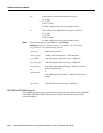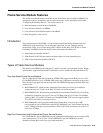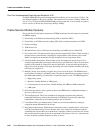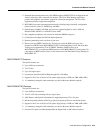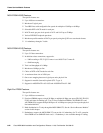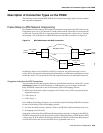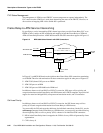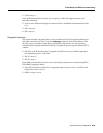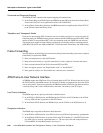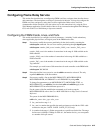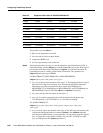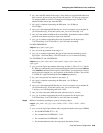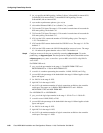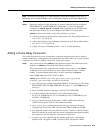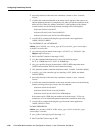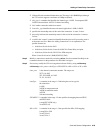
Description of Connection Types on the FRSM
Cisco MGX 8850 Installation and Configuration, Release 1.1.00, Part Number 78-6186-02
6-26
Command and Response Mapping
The FRSM provides command and response mapping in both directions:
• In the Frame Relay-to-ATM direction, the FRSM maps the C/R bit of the received Frame Relay
frame to the CPCS-UU least significant bit of the AAL5 CPCS PDU.
• In the ATM-to-Frame Relay direction, the FRSM maps the least significant bit of the CPCS-UU
to the C/R bit of the Frame Relay frame.
Translation and Transparent Modes
Each service interworking (SIW) connection can exist in either translation or transparent mode. In
translation mode, the FRSM translates protocols between the FR NLPID encapsulation (RFC 1490)
and the ATM LCC encapsulation (RFC 1483). In transparent mode, the FRSM does not translate.
Translation mode support includes address resolution by transforming address resolution protocol
(ARP, RFC 826) and inverse ARP (inARP, RFC 1293) between the Frame Relay and ATM formats.
Frame Forwarding
You can configure an individual port for frame forwarding. Frame forwarding is the same as standard
Frame Relay except that the FRSM:
• Does not interpret the two-byte Q.922 header.
• Maps all received frames to a specific connection if it exists, otherwise it discards the frames.
• Does not map between DE and CLP or between FECN and EFI.
• Does not support statistics for “Illegal header count” or “Invalid DLCI.”
• Does generate statistics for “Discarded frame count due to no connection.”
ATM/Frame-to-User Network Interface
All FRSMs support the ATM Frame User-to-Network Interface (FUNI). When a frame arrives from
the FUNI interface, the FRSM removes the 2-byte FUNI header and segments the frame into ATM
cells by using AAL5. In the reverse direction, the FRSM assembles ATM cells from the network into
a frame by using AAL5, adds a FUNI header to the frame, and sends it to the FUNI port.
Loss Priority Indication
The FRSM maps the loss priority indication for both directions:
• In the FUNI to ATM direction, the FRSM maps the CLP bit in the FUNI header to the CLP bit
of every ATM cell that it generates for the FUNI frame.
• In the ATM-to-FUNI direction, the FRSM always sets the CLP bit in the FUNI header to 0.
Congestion Indication
The FRSM maps congestion indication in both directions:
• In the FUNI-to-ATM direction, it sets EFCI to 0 for every ATM cell it generates by segmentation.
• In the ATM-to-FUNI direction, it sets the CN bit in the FUNI header to 1 if the EFCI field in the
last ATM cell of a received, segmented frame is 1. The two reserve bits (the same positions as
C/R and BECN in Frame Relay header) are always 0.



